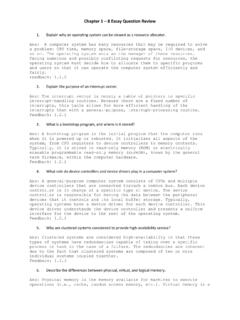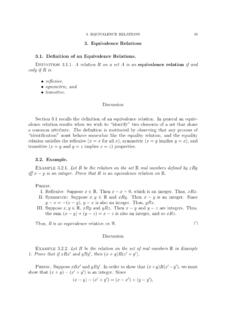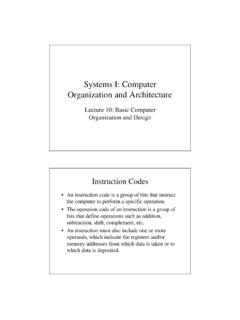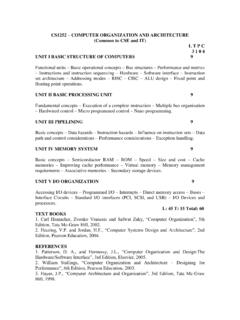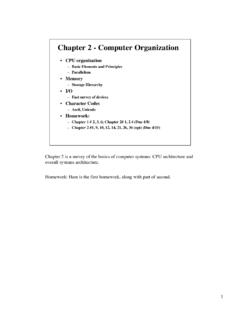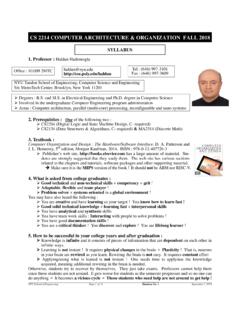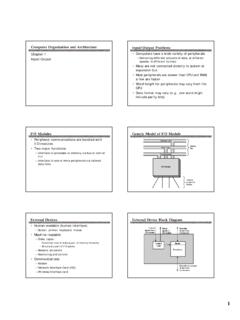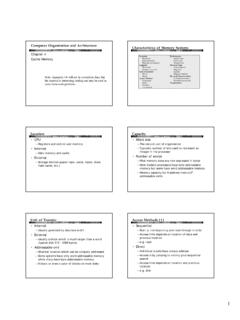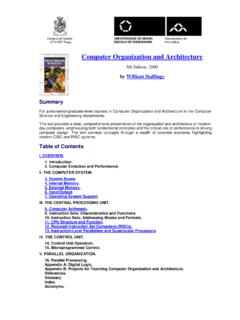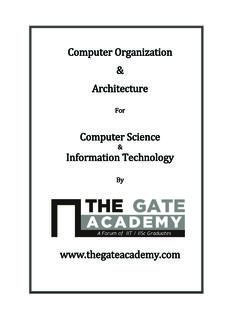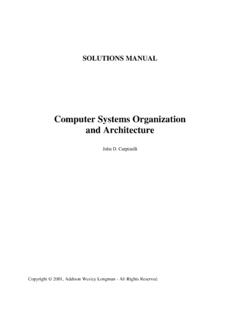Transcription of CDA 3100 - Computer Organization I
1 Page 1 of 6 CDA 3100 - Computer Organization I Fall 2019, Department of Computer Science, Florida State University Class time and location Lectures: Monday, Wednesday, and Friday, 11:15AM 12:05PM, HCB 315 (HCB Classroom Building) Recitation Sessions: Section 1, Monday, 09:05AM 09:55AM, LOV 301 (Love Building) Section 2, Tuesday, 09:30AM 10:20AM, HWC 3503 (Health and Wellness Center) Section 3, Wednesday, 09:05AM 09:55AM, LOV 301 (Love Building) Section 4, Thursday, 09:30AM 10:20AM, HCB 317 (HCB Classroom Building) Special note: The classrooms for recitation sessions may change to MCH 202 during the semester when the room is restored.
2 Instructor Xiuwen Liu Email: (strongly preferred means of remote communication) Home page: ~liux Office: 168 Love Building (LOV) Phone: (850) 644-0050 Office Hours: Monday and Wednesday from 08:10AM 8:50AM and 10:30AM-11:00AM, and by appointments Teaching Assistants Seyed Meysam Ghaffari Dehkordi (Grading of Homework Assignments 1 and 8; Recitation Sessions for Weeks 2, and 12, 13, and 15) Email: Office: 338 Dittmer (inside 336 Dittmer) (Dittmer Chemistry Lab (DLC)) Office hour: Friday 10:00AM 11:00AM and by appointments Shaeke Salman (Grading of Homework Assignments 2, 3, 5, and 6; Recitation Sessions for Weeks 3-5 and 9-11) Email: Office: TA Desk 19, 336 Dittmer (Dittmer Chemistry Lab (DLC)) Office hours: Tuesday, 03:00PM 05:00PM and by appointments Tonmoy Dey (Grading of Homework Assignments 4 and 7; Recitation Sessions for Weeks 6-8) Email: Office: 206 LOV (Love Building) Office hour: Thursday, 11:00AM 12:00 Noon and by appointments Course Home Page ~liux/courses/cda3100 This web site contains the up-to-date information related to this course such as news, announcements, assignments, lecture notes, and useful links to resources that are helpful to this class.
3 Announcements Page 2 of 6 on this web page are OFFICIAL for this class. Besides the course home page, this class will also use Canvas for class communication and management. Course Rationale Arguably Computer revolution is one of the most fundamental ones in the human history and it has changed and will be changing every aspect of the society and human life due to the following reasons: - Separation of the software and hardware allows the same hardware to be used to solve different problems by only changing the software, leading to general purpose computing machines. - Technology advances have led to over 250,000,000,000 improvements in relative performance / unit cost in half a century and no other industry has done so ever.
4 - The number of operations that can be performed per unit energy consumed by computers is many orders of magnitudes larger than any other physical systems, creating a unique cyber space, where many conventional concepts are completely redefined ( , cyber warfare), creating new challenges and new opportunities, especially for the Computer science community. During the evolution, numerous innovations have been created and are still being created, resulting in countless new research areas, companies, and job opportunities; Computer architecture provides the foundation for such innovations. As the first course in a two-course sequence on Computer Organization , this course exposes fundamentals of the exciting Computer systems, including building blocks of Computer hardware (gates and memory elements), instruction set architectures (instruction sets and assembly language programming), and design of various components.
5 By gaining much deeper understandings of Computer systems, students will be able to lay a solid foundation to further their studies in Computer Organization , operating systems, compilers, high performance computing, cyber security, and other related areas. Furthermore, this class, along with other ones, prepares Computer science major students for job opportunities and research areas otherwise not feasible. Course Description This is the first course (of a two-course sequence) in Computer Organization intended for Computer science and closely related majors with previous C/C++ background.
6 It introduces fundamental concepts in Computer Organization and digital logic design, including Computer arithmetic, including general number representation, two s complement, binary arithmetic (addition, subtraction, multiplication, and division, including overflow detection), and floating point representation (including the IEEE 754 floating point standard). MIPS instruction set, including different formats and addressing modes, encoding, and decoding. Introduction to instruction set design, including an overview of the Intel IA-32. Assembly programming using MIPS, including understanding of assembler. Digital logic design, including basic logic gates and their use in constructing combinational logic (decoders, multiplexors, an arithmetic logic unit, and programmable logic arrays), and sequential logic (such as flip-flops, latches, registers, and memory elements, and finite state machines).
7 Processor design, including a single cycle implementation and introduction to multicycle implementation. Performance assessment and comparison; factors that affect performance and performance models. Prerequisites Corequisites: COP3330 (Object Oriented Programming) and MAD2104 (Discrete Mathematics I). Page 3 of 6 - C/C++ Programming Able to program proficiently using either C or C++ (note, however, skeleton codes for assignments will be given in C); this class uses C program examples for illustration and several assignments require implementations in C (C++ can be used also). - Discrete Mathematics Familiar with basic elements of digit logic.
8 Course Objectives Upon successful completion of this course of study a student would: Know number representations; be able to compute the represented quantity (value) of a number in a specified representation system and be able to convert number representations between different representation systems. Know algorithms for binary arithmetic operations; be able to perform addition, subtraction, multiplication, and division using binary numbers. Know floating point number representations and IEEE 754 floating-point standard; be able to encode and decode floating point representations in IEEE 754 standard; be able to perform floating-point operations using IEEE 754 representations.
9 Know the MIPS instruction set; be able to encode and decode MIPS instructions. Know MIPS assembly language; be able to read and write functions using the MIPS assembly language. Know MIPS calling conventions; be able to read and write programs consisting of multiple functions in MIPS assembly; be able to show the stack of recursive functions in MIPS assembly. Understand different types of instruction set architectures; be able to compare different instruction set architectures for a given (simple) function. Understand Intel calling convention and the overall Intel-32 instruction set architecture ; be able to understand simple assembly programs in Intel-32 instructions.
10 Know how to design combinational logic, including decoders, multiplexors, and simple arithmetic-logic units; be able to design decoders, multiplexors, and arithmetic-logic units using basic logic gates. Know carry-lookahead adders; be able to construct a carry-lookahead adder using basic logic elements. Know sequential logic elements including flip-flops, latches, and memory elements and know to apply them to construct large components; be able to construct the state diagram of sequential logic elements and be able to design flip-flops, latches, and memory elements using basic logic gates. Be able to use the Verilog programming language to describe simple circuits.





